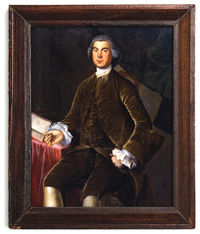“Treading the reforming justice out of me”
Yesterday we bravely accompanied James Murray, a justice of the peace known to be friendly to the royal government, into Faneuil Hall as two Whig magistrates heard a charge against William Burnet Brown for helping to assault James Otis, Jr., in September 1769.
According to a letter Murray wrote at the end of the month, selectman Jonathan Mason chided the crowd for jostling him, even if everyone knew he was no fan of Otis.
Then, lending me his hand, [Mason] helped me over the door into the selectmen’s seat. Before I got down from the seat I was hiss’d. I bowed. I was hiss’d again, and bowed around a second time. Then a small clap ensued. Compliments over, I sat down.The justices of the peace presiding at this session were Richard Dana and Samuel Pemberton. Murray had the status to sit beside them and render judgment—but of course he knew he would be outvoted.
The justices asked me up to the bench. I declined.
The examination of some evidence [i.e., witness] was continued, and, being finished, the justices thought fit to bind over Mr. Brown. He lookt about for bail. No one offered but I.According to Dr. Thomas Young, the printer John Mein also offered to be one of Brown’s “sureties.” That of course didn’t make Mein any more popular with the crowd. (This was several weeks before he was driven into hiding, as discussed here.)
Murray insisted that his offer to put up bail for Brown didn’t mean he supported one side of the the British Coffee-House brawl:
Here I desired the justices to take notice that I did not mean by this offer to vindicate what Mr. Brown had done, but only to stand by him now the torrent was against him. The recognizance taken, the justices desired the people to disperse, for that Mr. Brown had complied with the law; but the crowd, intending more sport, still remained.Gray, Taylor, and the Debois brothers were all Boston merchants who became Loyalists during the war. Taylor eventually moved back to Massachusetts.
As I was pressing out next to Mr. Dana, my wig was pulled off, and a pate, clean shaved by time and the barber, was left exposed. This was thought a signal and prelude to further insult, which would probably have taken place but for hurting the cause.
Going along in this plight, surrounded by the crowd, in the dark, Lewis Gray took hold of my right arm and Mr. William Taylor of my left, and supported me, while somebody behind kept nibbling at my sides and endeavoring to trip me; for the pleasure, as may be supposed, of treading the reforming justice out of me by the multitude.
Mr. [Gilbert or Louis] Deblois threw himself in my rear, and suffered not a little in my defence. Mr. G. Hooper went before, and my wig, disheveled, as I was told, was borne on a staff behind.
The gentlemen, my friends and supporters, offer’d to house me near the Hall, but I insisted on going home in the present trim, and was by them landed in safety, Mr. Gray and others having continually thus admonished my retinue in the way, “No violence, or you’ll hurt the cause.”
I’m guessing that “Mr. G. Hooper” was George Hooper (1747-1821), a son of the late Rev. William Hooper of Trinity Church. Murray promised to look after that family when the minister died in 1767.
Murray had lived for decades in North Carolina, and he probably helped the Hooper brothers set themselves up in that colony. Oldest surviving brother William, having studied law under Otis, started a practice in Wilmington. He became politically active and eventually signed the Declaration of Independence.
George Hooper followed William to the Wilmington area by the 1770s, worked as a merchant, and held some local offices. In 1780 he was suspected of having Loyalist sympathies and left for Charleston, South Carolina. Since that city had fallen into British hands, that looks like the sort of thing a Loyalist would do. But Hooper’s brother and father-in-law, both active Patriots, advocated for him and he managed to come back to Wilmington after the war. Eventually he was the first president of the Bank of Cape Fear.
Murray’s experience on 6 Sept 1769 might have been the inspiration for this engraving, which appeared in James S. Loring’s Loyalists of Massachusetts. Having tried to describe the situation with detached wit, the justice wouldn’t have appreciated this depiction.



